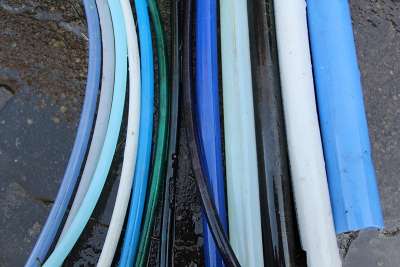We’ve been rebuilding a major section of one of our sugarbushes this summer with the idea that this time we’re going to do it right. We first started building this particular bush in the early 1980s, which was really only a decade or so into the plastics era in sugaring. The manufacturers and the sugarmakers were still learning. We thought we were innovative because we suspended our mainline on wire instead of draping it along the ground like some guys still did, which in hindsight we were, but of course there was plenty we did that even a decade later we shook our heads at. Our lateral lines drooped from tree to tree – this was before the plastic was semi-rigid – and it expanded and contracted mightily, which was a pretty major flaw in the technology. We used half-inch mainline, which was too small. We used 7/16-inch spouts – everybody did – which wounded the trees unnecessarily.
We rebuilt the woods in the 1990s with the idea of doing it right. We bumped up the size of our mainlines to three-quarter inch; we replaced the droopy laterals with the newer, semi-rigid tubing that held a pitched line better; we went to health spouts, which decreased wounding in the trees. But we still thought nothing of putting 10, 20, 30 taps on a lateral, which was about to become a bad idea.
We rebuilt the woods again in the early 2000s – yup, that time, too, we were going to do it right. Vacuum was becoming all the rage – “get air to the tapholes!” the gurus would say – so much of our three-quarter-inch mainline was now too small. The health spouts had fallen out of favor for spouts with replaceable tips. The mantra on lateral lines among innovative producers was “strive for five” – you didn’t want any more than five taps per line. And so we put out all kinds of new mainlines. All of us producers bragged that there was so much mainline in our woods you’d think it was lateral line.
And yet this summer, as I was taking our formerly-state-of-the-art infrastructure down, I often wondered: what were we thinking? In our race to put up wire we rendered many trails and woods roads obsolete, which have become important because we’re big enough now, and old enough, that it’s really handy to have a UTV to haul equipment around. My mantra putting up laterals is now “no more than three.” Some mainlines are still too small, and so much of what a decade ago seemed creative today seems daft. In places, instead of an espalier pattern that allowed laterals to connect with the mainlines at 90 degrees, we often laid things out in a kind of chevron pattern that had the laterals coming in at 45 degrees. We just didn’t see it right when we were building it.
Some of these mistakes we can pass the buck on. Technology changes and makes things obsolete – the old droopy plastic is a perfect example. We also grew, which made certain practices obsolete; for instance, the mainline is perpetually undersized because we keep adding taps. But some of this is squarely on us. Our perspectives change as we grow older. We learn. Things we couldn’t see before suddenly become apparent.
There’s something very hopeful about this; we’re thinking apes – that we’re perpetually curious, that we’re always learning, is our species’ gift. But it’s kind of terrifying, too. What forestry practices are we implementing now that we’re going to look back on and shake our heads at? What parenting techniques? What conservation practices? One of our board members pointed out once, and it stuck with me, that if conservation easements had been put in place in the late 1700’s, the focus would have been on razing forests for agriculture, potash, and charcoal production.
Certainly some food for thought there.
Anyway, it’s Friday. Tomorrow I’m heading back out in the bush early and I’m going to make some real progress this weekend. This time, THIS TIME, damn it, we’re going to do it right.



Discussion *